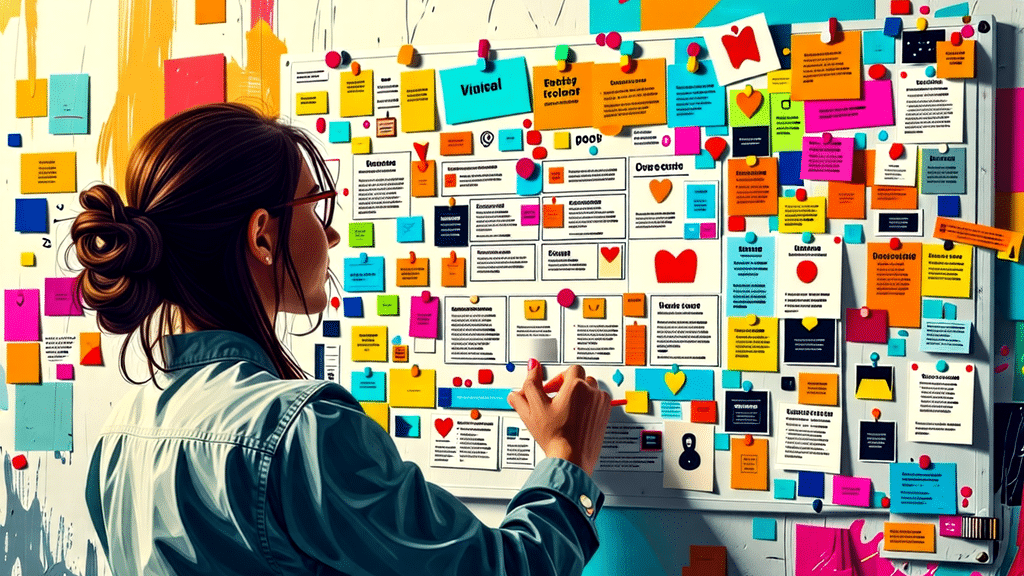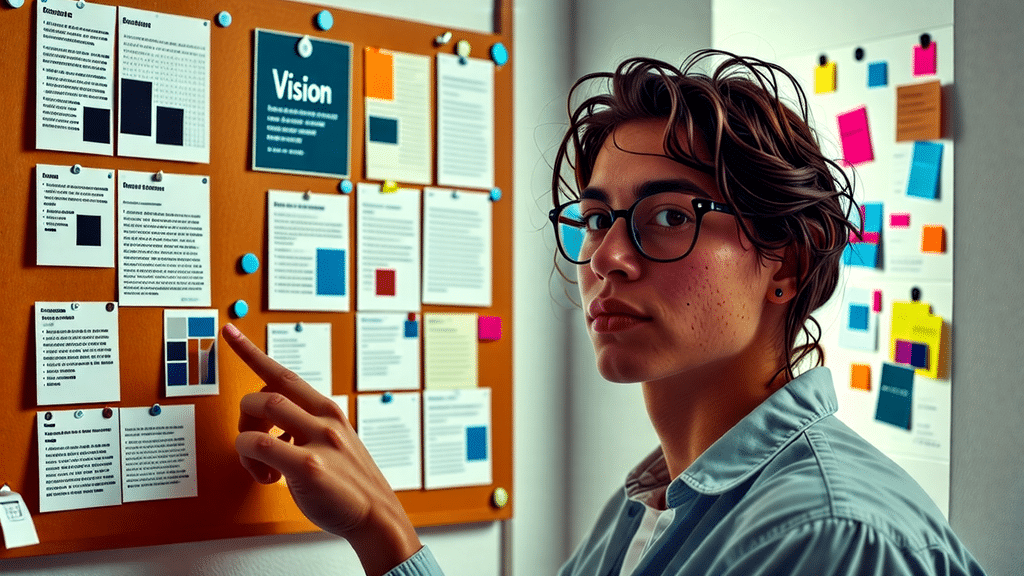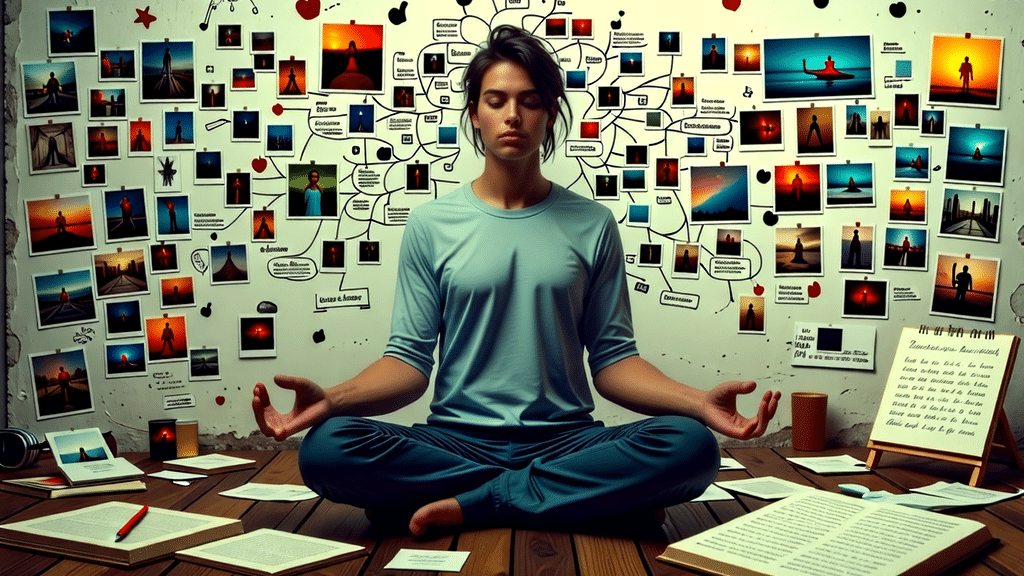Have you ever wondered how to visualize the future? You’re not alone. In fact, many of us find ourselves at the edge of a vast valley called the future, unsure of what lies beyond. But fear not, for we have a compass to guide us – visualization.
As renowned photographer Ansel Adams said, “You don’t take a photograph, you make it.” Similarly, picturing our future isn’t a passive act, it’s an active crafting process. This blog post will equip you with visualization techniques and insights to powerfully visualize a positive future and set your goals.
From Gary Hart’s teachings to Mel Robbins’ podcast insights, we’ll delve into a comprehensive approach towards visualizing your future. Buckle up, it’s time to see beyond the valley view and harness the power of visualization.
Key Takeaways
- Visualization is an effective tool for projecting into the future and setting goals. It’s an active process that aids in shaping desired outcomes.
- Memory and self-perception can be positively influenced by visualization. It can help in overcoming trauma and challenges by encouraging a positive outlook.
- There are multiple visualization techniques, including daily practices and the creation of vision boards. These methods can aid in making the visualization process more tangible and actionable.
- Emulating the visualization process of accomplished individuals, such as Ansel Adams, can provide inspiration and a framework for personal visualization strategies.
- The practice of visualization isn’t always straightforward. Some individuals might struggle with it. However, there are strategies and solutions available to overcome these hurdles and fully engage with this powerful self-development tool.

The Science of Visualization: Why is it Important?
Understanding the vital role of visualization in achieving desired outcomes is intriguing. This art of mental rehearsal fosters positivity and prepares us to face challenges head on. Harnessing the power of visualization, as Gary Hart did, can help in creating a compelling vision of the future. When we vividly visualize our goals, we essentially visualize the future, making it appear more tangible.
However, it’s important to note that visualization isn’t limited to merely ‘seeing’ a future outcome. It involves all the senses, making the experience more real and impactful.
You can even apply visualization techniques to heal from trauma, as suggested on the Mel Robbins Podcast here. So, whether you’re looking for a valley view reflection or seeking to overcome an inability to visualize, remember: visualizing a positive future is a journey, not a destination.
How Visualization Alters Memory and Self-Perception
Immersing ourselves in vivid mental scenarios of our ambitions helps us visualize the future. This is not a mere daydream; it’s a proactive maneuver to refine our self-perception and reshape our memories. Using tools such as vision boards, we can paint a detailed picture of our aspirations, giving them a palpable sense of reality. By consciously engaging with our senses during this process, we elevate the experience from a mere mental exercise to a tangible preview of our goals.
On my blog, I’ve shared some valuable insights on how to adopt this powerful technique. Acknowledging the challenges some face with visualization, we find solace in knowing there are ways to overcome these, as detailed here. Just like Ansel Adams did, let’s harness the power of visualization to mold a positive future.

Visualization Techniques: A Step-by-Step Guide
Delving into the process of visualization, we begin by crafting a vivid mental image of our aspirations. Just as Ansel Adams captured the spectacular valley view, we can frame our future in our minds. The key lies not in the clarity of the image, but in the emotion it evokes. We don’t just visualize, we feel, hear, and sense our future.
This multisensory approach deepens our connection with our desired outcome, making it more than just a distant dream. Our blog post here offers more insights on this technique. Healing from trauma, too, can be aided by such visualization techniques, turning painful memories into positive future possibilities. As we continue to visualize the future, we’re essentially drawing our own roadmap to success.
5 Effective Techniques to Visualize Your Goals
Borrowing from the success stories of accomplished individuals, such as Ansel Adams, let’s explore five handy ways to make your dreams more tangible by visualizing them.
- Mind Mapping: This creative strategy involves drawing diagrams that represent your goals, stimulating both logical and creative thinking.
- Meditation: A quiet mind can visualize a future more effectively. Meditative practices can help clear mental clutter, allowing for more vivid visualization.
- Vision Boards: Physical representations of your goals can stimulate a stronger emotional connection, making the visualization process more impactful.
- Affirmations: Positive affirmations can align your mindset with your goals, making the visualization more potent.
- Journaling: Writing down detailed descriptions of your goals can enhance the visualization process.
Overcoming trauma through visualization techniques, as we discussed in a previous post, can also play a crucial role in visualizing a positive future.

Powerfully Visualizing a Positive Future Amid Trauma
Amidst life’s challenges and traumatic experiences, it’s essential to visualize your future, casting it in a positive light. This advanced form of visualization encourages your mind to focus on the goals you aspire to achieve. Through the utilization of distinct visualization techniques, you can effectively tap into the power of your subconscious mind to shape a positive future. Consider the valley view analogy, where traumas are the valleys.
By using visualization techniques, you can transform these valleys into mountains, symbolizing growth and progress. Just like Ansel Adams captured breathtaking views using his lens, you too can capture an inspiring future using your mental lens. Bear in mind that the inability to visualize can be overcome with practice and patience.
From Visualization to Reality: The Role of Practice
Transitioning your dreams into reality necessitates more than just envisioning the end goal; it calls for dedicated and consistent practice. In fact, the process of transforming your mental images into tangible outcomes is akin to moving from the valley floor to the mountain top. Each step you take represents the practice needed to reach the peak, which symbolizes your aspirations. Our previous article pointed out that visualization is a powerful tool that can propel you towards your ambitions. However, it’s not an overnight solution; it requires time and effort. Like a photographer patiently waiting for the perfect light to capture the valley view, you too should persistently practice visualization techniques to enhance your ability to craft a positive future.

How to Practice Visualization in Daily Life
Incorporating visualization practices into your daily routine, like the view from a mountaintop, can help turn your goals into reality. This can be achieved by setting aside a specific time each day to visualize the future. Start by closing your eyes and taking deep, calming breaths.
Now, paint a mental image of your positive future. Visualize each detail clearly – the achievements, the triumphs over trauma, the joy and satisfaction. Feel the emotions associated with these images, making the experience as real as possible. Remember, the key is in constant practice – like a river carving a valley, your consistent efforts will eventually shape your desired future.
The Power of Vision Boards in Visualization
Harnessing the potential of vision boards can amplify the process of visualization. Picture yourself standing in a valley, gazing at a panoramic view of your dreams, goals, and aspirations pinned on your vision board. Each image, like a detailed blueprint, helps to visualize the future more vividly.
Seeing these images daily imprints them in your subconscious, gradually guiding your actions towards realizing these goals. This can be especially beneficial in overcoming trauma, where a tangible depiction of a positive future can serve as a powerful motivator.
It’s like turning the valley view into a mountain peak, symbolizing growth and progress. Refer to this article to gain more insights into visualization techniques.

7 Steps to Create an Effective Vision Board
To craft a potent vision board, follow this simple, seven-step process.
- Define your aspirations clearly.
- Father materials related to your goals. This could be pictures, affirmations, or quotes.
- Arrange the elements on your board in a way that resonates with your senses.
- Place it in a visible location. Make sure it’s a place you often see, like your workspace.
- Spend time with your vision board daily, allowing the images and words to imprint on your subconscious.
- Take action, because a vision board is no substitute for real-life effort.
- Lastly, update your board regularly as your goals evolve. This process mirrors the transformative journey of turning a valley view into a mountain peak. For inspiration, check out Gary Hart’s photography.
The Art of Visualization: A Glimpse into Ansel Adams’ Approach
Peering into the creative process of Ansel Adams offers unique insights into visualization’s power. His iconic “Valley View” became a reality only after he could visualize it in his mind. Similarly, for us, visualizing a positive outcome breathes life into our ambitions.
Mindful practice of visualization techniques equips us to ascend from trauma-filled valleys to peaks of triumph. Imagine standing atop a mountain, the future you seek sprawled out before you just like Adams’ valley view. This future is within reach if we learn to visualize it consistently. Much like a photographer capturing the perfect shot, visualizing our future requires patience, practice, and perspective.

Creating an Image from Start to Finish: Ansel Adams’ Method
Crafting an image from inception to completion, the technique of Ansel Adams offers profound insight. His method of previsualization, a concept of visualizing the desired end result before even taking the shot, can be applied to our lives. Just as Adams would visualize his valley view before immortalizing it in a photograph, we too can visualize a positive outcome to steer our lives in the desired direction.
However, this requires consistency in practicing visualization. When you find yourself in a valley of trauma, imagine your view from the mountain peak, a future free from distress. For a deeper understanding of previsualization, this insightful blog post is worth a read.
Overcoming Barriers: Visualizing a Future Amid Challenges
Reframing challenges and picturing solutions is a vital part of dealing with life’s obstacles. By choosing to visualize a positive future, even when confronted with adversity, you’re leveraging your mind’s power to shape your reality. It’s like viewing the world from a valley’s bottom and imagining the breathtaking panorama from the summit.
You might not see it yet, but with persistent visualization practice, you can climb that mountain. The inability to visualize can feel crippling, but it’s not permanent. Techniques like valley view reflections can help. An illuminating post on the subject is there to guide you on your visualization journey.
Dealing with Inability to Visualize: Strategies and Solutions
When struggling with the power to visualize, there are practical steps you can take. The key is to begin small and remain consistent. You could start with short, daily sessions of guided imagery. This involves focusing on specific scenarios or images, such as a valley view, which can help you gradually develop your visualization ability. Another approach involves practice visualization through the creation of vision boards.
This tangible representation of your future captures your dreams and ambitions, making them easier to visualize. You can also use affirmations, spoken or written statements that reinforce your ability to visualize a positive future. Remember, the journey is unique for everyone; patience and persistence are vital.
Conclusion
From Ansel Adams‘ approach to creating visual masterpieces to the neuroscience of visualization, this exploration of the power and practice of mental imagery has traversed a wide spectrum. It is evident that visualizing a desirable future is not only a potent tool for personal development but also a significant means of overcoming challenges and uncertainties.
The art of visualization is a journey, a transformative process that requires consistent practice. It’s not about perfection, it’s about progress. It’s about taking a step forward, even when the road is murky. This technique serves as a beacon that illuminates the path leading towards your goals.
Remember, even in the face of trauma or difficulties, the power to shape your future lies within your mind. Your vision board may be filled with images and words, but it is your determination and the actions you take that will turn those dreams into reality.
Embrace the process, stay consistent, and most importantly, believe in your ability to craft your desired future. After all, as Paul Brandt said, “Don’t tell me the sky’s the limit when there are footprints on the moon.”
